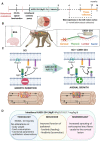Inhibiting an inhibitor: a decoy to recover dexterity after spinal cord injury
- PMID: 32543695
- PMCID: PMC7296859
- DOI: 10.1093/brain/awaa175
Inhibiting an inhibitor: a decoy to recover dexterity after spinal cord injury
Abstract
This scientific commentary refers to ‘Nogo receptor decoy promotes recovery and corticospinal growth in non-human primate spinal cord injury’, by Wang et al. (doi:
Figures

Comment on
-
Nogo receptor decoy promotes recovery and corticospinal growth in non-human primate spinal cord injury.Brain. 2020 Jun 1;143(6):1697-1713. doi: 10.1093/brain/awaa116. Brain. 2020. PMID: 32375169 Free PMC article.
Similar articles
-
The role of timing in the treatment of spinal cord injury.Biomed Pharmacother. 2017 Aug;92:128-139. doi: 10.1016/j.biopha.2017.05.048. Epub 2017 May 20. Biomed Pharmacother. 2017. PMID: 28535416 Review.
-
Inhibition of Nogo expression to promote repair after spinal cord injury.Chin Med J (Engl). 2012 Nov;125(22):4044-8. Chin Med J (Engl). 2012. PMID: 23158140
-
Regulation of axonal regeneration by the level of function of the endogenous Nogo receptor antagonist LOTUS.Sci Rep. 2017 Sep 21;7(1):12119. doi: 10.1038/s41598-017-12449-6. Sci Rep. 2017. PMID: 28935984 Free PMC article.
-
[Effects of Jisuikang on Nogo-NgR gene expression in spinal cord rats with injury].Zhongguo Gu Shang. 2015 Mar;28(3):235-9. Zhongguo Gu Shang. 2015. PMID: 25936193 Chinese.
-
The Brain Is Needed to Cure Spinal Cord Injury.Trends Neurosci. 2017 Oct;40(10):625-636. doi: 10.1016/j.tins.2017.08.002. Epub 2017 Sep 8. Trends Neurosci. 2017. PMID: 28893422 Review.
References
Publication types
MeSH terms
Substances
Grants and funding
LinkOut - more resources
Full Text Sources
Other Literature Sources
Medical

